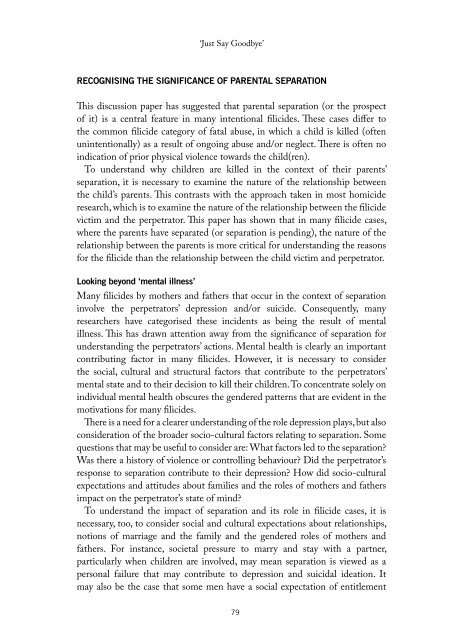‘Just Say Goodbye’ (January 2013 online edition)
‘Just Say Goodbye’ (January 2013 online edition)
‘Just Say Goodbye’ (January 2013 online edition)
- No tags were found...
You also want an ePaper? Increase the reach of your titles
YUMPU automatically turns print PDFs into web optimized ePapers that Google loves.
<strong>‘Just</strong> <strong>Say</strong> <strong>Goodbye’</strong>Recognising the significance of parental separationThis discussion paper has suggested that parental separation (or the prospectof it) is a central feature in many intentional filicides. These cases differ tothe common filicide category of fatal abuse, in which a child is killed (oftenunintentionally) as a result of ongoing abuse and/or neglect. There is often noindication of prior physical violence towards the child(ren).To understand why children are killed in the context of their parents’separation, it is necessary to examine the nature of the relationship betweenthe child’s parents. This contrasts with the approach taken in most homicideresearch, which is to examine the nature of the relationship between the filicidevictim and the perpetrator. This paper has shown that in many filicide cases,where the parents have separated (or separation is pending), the nature of therelationship between the parents is more critical for understanding the reasonsfor the filicide than the relationship between the child victim and perpetrator.Looking beyond ‘mental illness’Many filicides by mothers and fathers that occur in the context of separationinvolve the perpetrators’ depression and/or suicide. Consequently, manyresearchers have categorised these incidents as being the result of mentalillness. This has drawn attention away from the significance of separation forunderstanding the perpetrators’ actions. Mental health is clearly an importantcontributing factor in many filicides. However, it is necessary to considerthe social, cultural and structural factors that contribute to the perpetrators’mental state and to their decision to kill their children. To concentrate solely onindividual mental health obscures the gendered patterns that are evident in themotivations for many filicides.There is a need for a clearer understanding of the role depression plays, but alsoconsideration of the broader socio-cultural factors relating to separation. Somequestions that may be useful to consider are: What factors led to the separation?Was there a history of violence or controlling behaviour? Did the perpetrator’sresponse to separation contribute to their depression? How did socio-culturalexpectations and attitudes about families and the roles of mothers and fathersimpact on the perpetrator’s state of mind?To understand the impact of separation and its role in filicide cases, it isnecessary, too, to consider social and cultural expectations about relationships,notions of marriage and the family and the gendered roles of mothers andfathers. For instance, societal pressure to marry and stay with a partner,particularly when children are involved, may mean separation is viewed as apersonal failure that may contribute to depression and suicidal ideation. Itmay also be the case that some men have a social expectation of entitlement79


